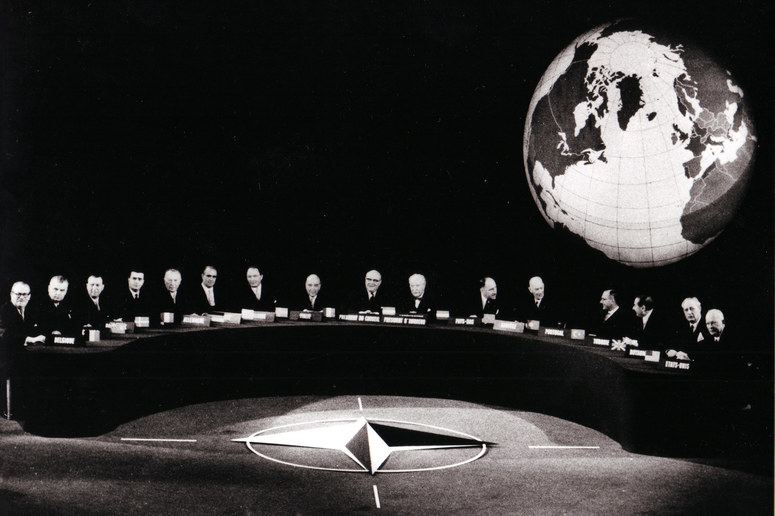On a crisp spring day in Washington, D.C., twelve nations signed an agreement that would reshape global power dynamics for generations to come. The North Atlantic Treaty Organization—better known as NATO—was born, a military alliance designed not just to defend the West but to solidify its influence in a world split by ideology.
The founding members—Belgium, Britain, Canada, Denmark, France, Iceland, Italy, Luxembourg, the Netherlands, Norway, Portugal, and the United States—had one common goal: to counter the looming threat of Soviet expansion. The Cold War had begun, and NATO was its first great chess move.
“Stalin’s Child”: The Justification for NATO’s Existence
Stathis Efstathiadis, writing for To Vima in 1999, captured the essence of NATO’s formation:
“NATO was born to counter the Soviet threat. That’s why, in the early days, it was often called ‘Stalin’s child.’ It grew strong because the Eastern Bloc was seen—whether by reality or by careful construction—as a menace. But that menace disappeared a decade ago, and now, it’s not so easy to invent new threats.”
For years, NATO’s very existence was justified by the idea of an aggressive Soviet Union waiting to expand into Western Europe. But what happens to a military alliance when its enemy disappears?
The West in Ruins, the East in Chains
Post-war Europe was in tatters. Bombed-out cities, shattered economies, and weakened militaries left nations vulnerable. Britain and France, once mighty empires, had drastically reduced their armed forces to cut costs. Meanwhile, communism was gaining political momentum in places like Italy and France, where leftist parties became powerful forces.
Across the Iron Curtain, the Soviet Union emerged from World War II bloodied but defiant. Red Army soldiers had pushed Nazi forces out of Central and Eastern Europe, but they never left. Instead, Stalin installed communist puppet governments, turning countries like Poland, Hungary, and East Germany into vassal states. Opposition was crushed. Political dissent was forbidden.
The “Iron Curtain” and the Truman Doctrine
The world took notice. On March 5, 1946, Winston Churchill delivered a chilling warning in Fulton, Missouri:
“From Stettin in the Baltic to Trieste in the Adriatic, an iron curtain has descended across the continent.”
The phrase caught fire, solidifying the East-West divide in the public imagination. A year later, the U.S. struck back with the Truman Doctrine, offering military and economic aid to countries threatened by communist takeover—most notably, Greece and Turkey.
Europe was now a battleground, not of bombs and bullets but of ideologies and alliances.
Greece Joins the Fold
By 1952, the alliance expanded. Greece and Turkey joined NATO, but the Greek entry came at a controversial cost. As journalist Stathis Efstathiadis noted, the Greek government—led by Nikolaos Plastiras and Sophoklis Venizelos—wanted to prove its anti-communist credentials.
In a grim coincidence, just as Greece’s NATO membership was being finalized in February 1952, 29 Greek communists, including prominent intellectual Nikos Batsis, were put on trial and sentenced to death. Their execution sent a clear message: Greece was firmly in the Western camp.
But Athens expected something in return—economic aid. The response? Vague promises. TO BHMA reported at the time:
“American investments in Greece will come only if positive guarantees are given.”
That help never fully materialized. Meanwhile, Greece found itself tied militarily to Turkey, with both nations’ naval forces placed under a single command in the Aegean. Tensions between the two uneasy allies would only grow in the years to come.
NATO Expands: From Germany to the Baltics
Over the decades, NATO grew beyond its original twelve members.
- 1955: West Germany joined, a move that infuriated the Soviet Union.
- 1982: Spain entered after emerging from Franco’s dictatorship.
- 1999: With the Cold War over, NATO welcomed former Eastern Bloc nations—Hungary, Poland, and the Czech Republic.
- 2004 Onward: A wave of ex-Soviet and Balkan countries, including Bulgaria, Romania, and the Baltic states, swelled NATO’s ranks.
The alliance that once stood as a Western bulwark against communism was now knocking on Russia’s doorstep.
A global map of NATO partners around the world (with all the sovereign states that are under 20,000 km2 in area represented by a circle) NATO member states Accession protocol signed Membership Action Plan Enhanced Opportunities Partner[1] Individual Partnership Action Plan Partnership for Peace (PfP) Mediterranean Dialogue (MD) Istanbul Cooperation Initiative (ICI) NATO global partners
Greece’s Dramatic Exit (and Return)
One of NATO’s greatest internal crises came in 1974. Following Turkey’s military invasion of Cyprus, Greece’s government, led by Konstantinos Karamanlis, took a radical step—it pulled Greece out of NATO’s military command structure.
In a scathing official statement, the Greek government declared:
“NATO has proven incapable of preventing Turkey’s barbaric and unprovoked assault on Cyprus… NATO has no reason to exist if it cannot stop war between its own members.”
For six years, Greece remained outside NATO’s military wing. But in October 1980, just months before its official entry into the European Economic Community (EEC), the government of Georgios Rallis announced Greece’s return to the alliance.
Unlike its departure, this move was deeply divisive. The socialist PASOK party and the Communist Party of Greece fiercely opposed the decision. Across the country, protests erupted under the now-famous slogan:
“EEC and NATO—same syndicate.”
2003: NATO’s Most Explosive Crisis
The Cold War was over, but NATO’s troubles were far from finished. The biggest rift in its history came in 2003, when the U.S. and Britain launched the Iraq War without UN approval.
Led by France and Germany, key NATO members refused to back the invasion, exposing deep fractures in the alliance. Some questioned whether NATO still served a clear purpose—or whether it had become, as some critics put it, a “war profiteers’ club.”
Professor Thanos Kakouriotis of Aristotle University of Thessaloniki argued:
“NATO began as a defensive alliance to halt communism. With communism gone, it transformed into an offensive force, justifying wars in Bosnia, Serbia, Afghanistan, and Libya. A U.S. invasion, when done under NATO’s flag, bypasses Congressional oversight.”
NATO Today: A Shadow of Its Former Self or More Powerful Than Ever?
In recent years, NATO has continued to expand.
- 2023: Finland joined, adding nearly 1,400 kilometers to NATO’s border with Russia.
- 2024: Sweden became the 32nd member, further tightening the alliance’s grip on Northern Europe.
But NATO now faces new questions. With Russia’s invasion of Ukraine, the alliance has found a renewed sense of purpose. Yet, internal divisions—over funding, leadership, and the future role of the U.S.—persist.
The Final Question: What Comes Next?
From its Cold War origins to its modern-day interventions, NATO has always adapted to the world’s changing power struggles. But its greatest test may still lie ahead.
Will it remain the pillar of Western security? Or will history prove that, like all empires, alliances, too, eventually crumble?
One thing is certain—NATO’s story is far from over.






